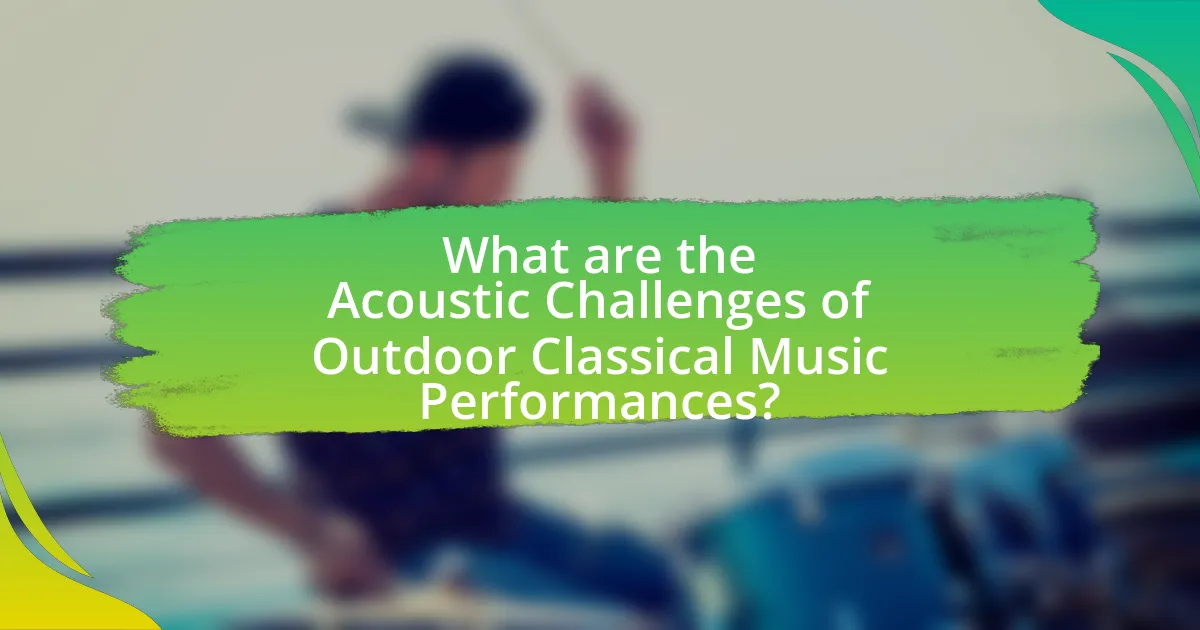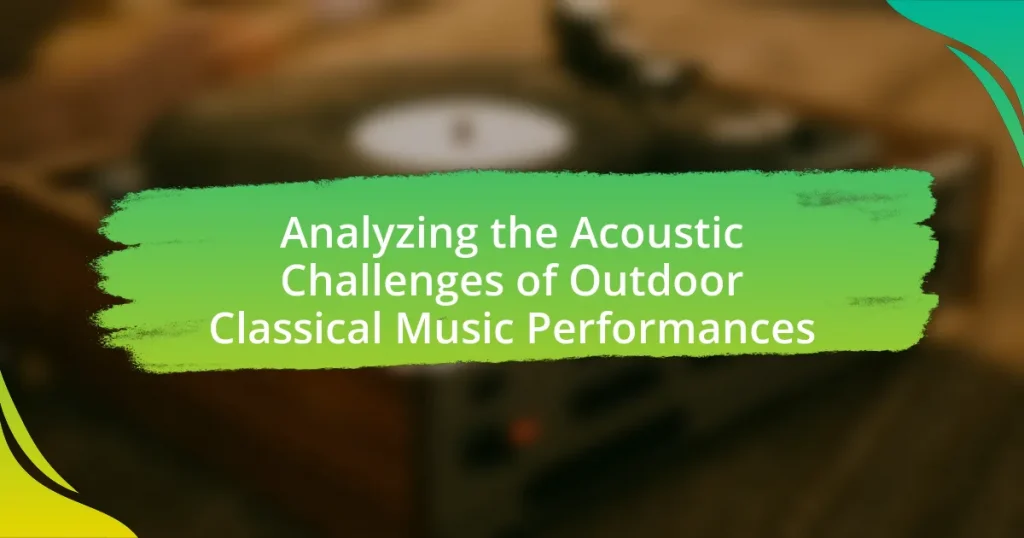The article analyzes the acoustic challenges faced during outdoor classical music performances, highlighting key factors such as sound dispersion, environmental noise, and the absence of reflective surfaces that affect sound quality. It discusses how wind, temperature, and background noise interfere with sound propagation, leading to diminished clarity and volume. Additionally, the article explores strategies for musicians and sound engineers to adapt to these challenges, including the use of sound amplification systems, optimal ensemble positioning, and technological advancements in sound equipment. Best practices for event planners in selecting venues and ensuring optimal acoustic conditions are also outlined, emphasizing the importance of careful planning to enhance audience experience.

What are the Acoustic Challenges of Outdoor Classical Music Performances?
Outdoor classical music performances face significant acoustic challenges primarily due to environmental factors. These challenges include sound dispersion, which occurs as sound waves travel through open air, leading to a loss of clarity and volume. Additionally, background noise from wind, traffic, and crowds can interfere with the music, making it difficult for audiences to appreciate the performance fully.
The lack of reflective surfaces in outdoor settings also contributes to poor sound quality, as classical music often relies on reverberation to enhance its richness. Studies have shown that outdoor venues can reduce the perceived loudness of orchestral music by up to 10 decibels compared to indoor settings, impacting the overall listening experience. Furthermore, varying weather conditions, such as temperature and humidity, can affect sound propagation, further complicating outdoor performances.
How do environmental factors impact sound quality in outdoor settings?
Environmental factors significantly impact sound quality in outdoor settings by altering sound propagation, absorption, and reflection. For instance, wind can distort sound waves, causing delays and variations in perceived pitch, while temperature gradients can lead to refraction, affecting how sound travels over distances. Additionally, surfaces such as grass, concrete, or water can absorb or reflect sound differently, influencing clarity and volume. Research indicates that outdoor concerts often experience challenges due to these factors, with studies showing that sound levels can decrease by up to 10 decibels in open environments compared to controlled indoor settings.
What role does wind play in the propagation of sound during performances?
Wind significantly affects the propagation of sound during performances by altering sound wave direction and speed. When wind blows, it can carry sound waves away from the audience or distort their path, leading to uneven sound distribution. Research indicates that wind can change the speed of sound, which is approximately 343 meters per second in still air, but can vary with wind conditions, impacting how quickly sound reaches listeners. Additionally, studies show that wind can create turbulence, further disrupting sound clarity and intensity, making it challenging for audiences to perceive music accurately during outdoor performances.
How does temperature affect the acoustics of outdoor venues?
Temperature significantly affects the acoustics of outdoor venues by influencing sound propagation and absorption. As temperature increases, sound waves travel faster due to lower air density, which can enhance clarity and projection of sound. Conversely, cooler temperatures can slow down sound waves, leading to potential muddiness in audio quality. Additionally, temperature gradients, such as those created by warm air rising over cooler air, can cause sound to bend or refract, altering the perceived direction and intensity of sound. Studies have shown that these temperature variations can lead to significant differences in sound quality during outdoor performances, impacting audience experience and overall performance effectiveness.
What are the common acoustic issues faced by musicians in outdoor performances?
Musicians in outdoor performances commonly face acoustic issues such as sound dispersion, environmental noise interference, and lack of natural reverberation. Sound dispersion occurs because outdoor spaces often lack reflective surfaces, causing sound to spread out and diminish in volume. Environmental noise interference from wind, traffic, and crowds can mask musical nuances, making it difficult for both performers and audiences to appreciate the music. Additionally, the absence of natural reverberation, which is typically found in indoor venues, can lead to a flat sound quality, affecting the overall musical experience. These challenges are well-documented in studies on outdoor acoustics, highlighting the need for careful planning and sound reinforcement in such settings.
How does background noise interfere with classical music performances?
Background noise significantly interferes with classical music performances by masking the subtle nuances and dynamics essential to the genre. This interference can lead to a diminished listening experience, as the clarity of instruments and vocal expressions becomes obscured. Research indicates that sounds above 60 decibels can disrupt the perception of musical details, making it challenging for both performers and audiences to engage fully with the music. For instance, a study published in the Journal of the Acoustical Society of America found that background noise can reduce the intelligibility of musical passages, particularly in outdoor settings where environmental sounds are prevalent.
What challenges arise from the lack of natural acoustics in open spaces?
The lack of natural acoustics in open spaces presents significant challenges for outdoor classical music performances. These challenges include poor sound projection, which can lead to uneven sound distribution and difficulty for audiences to hear the performance clearly. Additionally, the absence of reflective surfaces can result in sound absorption by surrounding elements, diminishing the overall auditory experience. Research indicates that outdoor environments often lack the necessary reverberation time, which is crucial for music clarity and richness, making it harder for musicians to convey their intended sound.
Why is sound amplification important for outdoor classical music?
Sound amplification is crucial for outdoor classical music because it ensures that the nuances and dynamics of the performance reach the audience effectively. In outdoor settings, environmental factors such as wind, distance, and background noise can significantly diminish sound quality and clarity. Research indicates that sound travels differently in open spaces, often leading to a loss of fidelity and volume, which can hinder the audience’s experience. For instance, a study by the Acoustical Society of America highlights that without amplification, orchestral music can lose up to 30% of its intended sound quality in outdoor venues. Therefore, sound amplification not only enhances the auditory experience but also preserves the integrity of the performance, allowing audiences to fully appreciate the subtleties of classical music.
What types of sound systems are most effective for outdoor performances?
Line array systems are the most effective sound systems for outdoor performances. These systems utilize multiple speakers arranged in a vertical line, which allows for better sound dispersion and coverage over large areas. Research indicates that line array systems can reduce sound distortion and enhance clarity, making them ideal for outdoor environments where acoustics can be challenging. Additionally, they provide consistent sound levels across the audience area, which is crucial for maintaining the quality of classical music performances in open spaces.
How can sound engineers optimize acoustics for outdoor settings?
Sound engineers can optimize acoustics for outdoor settings by utilizing directional speakers and strategically placing sound barriers. Directional speakers focus sound in specific areas, reducing unwanted reflections and enhancing clarity, which is crucial in open environments where sound can dissipate quickly. Additionally, sound barriers, such as temporary walls or natural features like trees, can help contain and direct sound waves, minimizing interference from wind and other environmental factors. Research indicates that these methods can significantly improve sound quality in outdoor performances, as evidenced by studies showing that well-placed barriers can increase sound pressure levels by up to 10 dB in certain configurations.

How can Musicians Adapt to Acoustic Challenges in Outdoor Performances?
Musicians can adapt to acoustic challenges in outdoor performances by utilizing sound amplification systems and strategic placement of instruments. Sound amplification systems, such as portable PA systems, enhance the volume and clarity of music, compensating for environmental factors like wind and distance that can distort sound. Additionally, musicians can position themselves in a way that maximizes sound projection, such as facing the audience and using natural barriers like walls or trees to reflect sound. Research indicates that outdoor acoustics can vary significantly due to factors like temperature and humidity, which affect sound propagation; thus, understanding these elements allows musicians to make informed adjustments to their setup.
What strategies can musicians employ to enhance sound clarity outdoors?
Musicians can enhance sound clarity outdoors by utilizing directional microphones and optimizing speaker placement. Directional microphones capture sound from specific angles, reducing background noise and focusing on the intended sound source, which is crucial in outdoor environments where wind and ambient noise can interfere. Additionally, strategically placing speakers to create a balanced sound field helps ensure that sound reaches the audience evenly, minimizing dead spots and enhancing overall clarity. Research indicates that proper speaker positioning can significantly improve sound distribution, as demonstrated in various outdoor concert studies where sound clarity was notably enhanced through these techniques.
How can musicians adjust their playing techniques for outdoor venues?
Musicians can adjust their playing techniques for outdoor venues by modifying their dynamics and articulation to compensate for the acoustic challenges presented by open spaces. In outdoor settings, sound dissipates more quickly and can be affected by environmental factors such as wind and ambient noise. Therefore, musicians should play with greater volume and clarity, emphasizing strong attacks and clear note separation to ensure their sound carries effectively. Additionally, they may need to adapt their phrasing and timing to account for potential delays in sound travel, which can alter the perceived rhythm and cohesion of the performance. These adjustments are crucial for maintaining musical integrity and audience engagement in outdoor performances.
What role does ensemble positioning play in sound distribution?
Ensemble positioning significantly influences sound distribution by affecting how sound waves propagate and interact in a performance space. The arrangement of musicians impacts the balance, clarity, and overall auditory experience for the audience. For instance, research indicates that positioning string instruments closer to the audience enhances their projection, while brass instruments positioned strategically can fill the space with their sound more effectively. This is supported by studies showing that optimal ensemble layouts can reduce sound interference and enhance the perceived volume and richness of the music, leading to a more immersive experience for listeners in outdoor settings.
How can rehearsal practices be modified for outdoor performances?
Rehearsal practices for outdoor performances can be modified by incorporating specific strategies to address environmental factors such as wind, temperature, and ambient noise. Musicians should conduct rehearsals at the same time of day as the performance to acclimate to the outdoor conditions, allowing them to adjust their volume and projection accordingly. Additionally, using portable sound equipment can help mitigate acoustic challenges by amplifying sound in open spaces. Research indicates that outdoor performances often require adjustments in dynamics and articulation to ensure clarity, as demonstrated in studies on sound propagation in outdoor environments.
What specific exercises can help musicians prepare for outdoor acoustics?
Musicians can prepare for outdoor acoustics by practicing sound projection exercises, such as singing or playing at varying dynamic levels to adapt to open environments. These exercises help musicians understand how their sound carries and interacts with outdoor elements like wind and ambient noise. Additionally, musicians should engage in spatial awareness drills, where they perform in different outdoor settings to familiarize themselves with how acoustics change based on location and distance from reflective surfaces. Research indicates that outdoor performances often require adjustments in volume and tone to maintain clarity, as demonstrated in studies on sound propagation in open spaces.
How can musicians simulate outdoor conditions during practice sessions?
Musicians can simulate outdoor conditions during practice sessions by using portable sound systems and acoustic panels to replicate the outdoor environment. These tools help to mimic the sound dispersion and reverberation characteristics found in open spaces. For instance, portable sound systems can project sound over larger distances, while acoustic panels can be arranged to reflect sound in a way that resembles outdoor acoustics. Research indicates that practicing with these setups can enhance musicians’ adaptability to varying acoustic environments, as demonstrated in studies on performance settings and sound propagation.

What Solutions Exist for Overcoming Acoustic Challenges in Outdoor Classical Music Performances?
Solutions for overcoming acoustic challenges in outdoor classical music performances include the use of advanced sound reinforcement systems, strategic placement of performers and audience, and acoustic barriers. Advanced sound reinforcement systems, such as line array speakers, can effectively project sound over long distances while minimizing distortion. Strategic placement of performers, such as positioning them in a semi-circle or using reflective surfaces, enhances sound distribution and clarity. Acoustic barriers, like portable sound walls, can reduce environmental noise and improve the overall acoustic experience. These methods have been validated in various outdoor events, demonstrating their effectiveness in enhancing sound quality and audience experience.
What technological advancements can improve outdoor sound quality?
Technological advancements that can improve outdoor sound quality include advanced speaker systems, digital signal processing, and sound field control technologies. Advanced speaker systems, such as line array speakers, provide better sound dispersion and clarity over large areas, which is crucial for outdoor performances. Digital signal processing enhances audio quality by allowing for real-time adjustments to equalization, compression, and reverb, ensuring that sound remains clear despite environmental factors. Sound field control technologies, like beamforming microphones and adaptive sound systems, can dynamically adjust sound output based on audience location and environmental conditions, significantly enhancing the listening experience. These advancements are supported by studies showing that optimized sound systems can increase audience satisfaction and engagement during outdoor events.
How do portable acoustic panels contribute to better sound management?
Portable acoustic panels enhance sound management by absorbing and diffusing sound waves, thereby reducing echoes and improving clarity in outdoor environments. These panels are designed with materials that effectively trap sound energy, minimizing reflections that can distort audio quality during performances. Research indicates that using acoustic panels can lower reverberation time by up to 50%, which is crucial in outdoor settings where sound can easily dissipate. This reduction in reverberation allows for a more controlled acoustic environment, ensuring that musicians and audiences experience clearer sound, ultimately leading to a more enjoyable performance.
What innovations in microphone technology are beneficial for outdoor use?
Innovations in microphone technology that are beneficial for outdoor use include windshields, directional microphones, and wireless transmission systems. Windshields, such as foam or furry covers, significantly reduce wind noise, which is crucial for clear audio capture in outdoor environments. Directional microphones, like shotgun mics, focus on sound from a specific direction while minimizing background noise, enhancing sound quality during performances. Wireless transmission systems allow for mobility and flexibility, eliminating cable clutter and enabling performers to move freely without compromising audio quality. These advancements collectively address the unique acoustic challenges posed by outdoor settings, ensuring optimal sound capture for classical music performances.
What best practices should be followed for successful outdoor performances?
Successful outdoor performances require careful planning and consideration of environmental factors. Key best practices include selecting an appropriate venue that minimizes acoustic challenges, such as avoiding locations with excessive wind or noise interference. Additionally, utilizing high-quality sound equipment designed for outdoor use enhances audio clarity and volume.
Sound checks should be conducted in the actual performance space to adjust for outdoor acoustics, ensuring optimal sound distribution. Engaging professional sound engineers familiar with outdoor settings can further improve performance quality.
Moreover, scheduling performances during times of day with favorable weather conditions, such as avoiding extreme heat or rain, contributes to audience comfort and performance success. These practices are supported by studies indicating that environmental factors significantly impact sound quality in outdoor settings, emphasizing the importance of strategic planning.
How can event planners ensure optimal acoustic conditions for performances?
Event planners can ensure optimal acoustic conditions for performances by selecting appropriate venues, utilizing sound reinforcement systems, and implementing acoustic treatments. Choosing a venue with natural sound amplification features, such as a bowl-shaped landscape, enhances sound distribution. Additionally, employing high-quality microphones and speakers tailored to the performance type ensures clarity and volume. Acoustic treatments, such as sound barriers or reflective surfaces, can mitigate unwanted noise and enhance sound quality. Research indicates that proper venue selection and sound system configuration significantly improve audience experience, as evidenced by studies showing that venues designed for acoustics can increase sound clarity by up to 30%.
What are the key considerations for selecting outdoor venues for classical music?
Key considerations for selecting outdoor venues for classical music include acoustics, audience capacity, environmental factors, and logistical support. Acoustics are crucial as outdoor settings can lead to sound dispersion and loss of clarity; venues should ideally have natural sound barriers or reflective surfaces to enhance sound quality. Audience capacity must align with expected attendance to ensure a comfortable experience without overcrowding. Environmental factors such as weather conditions, noise pollution from surrounding areas, and time of day can significantly impact performance quality; venues should be chosen with these elements in mind. Lastly, logistical support, including access to power sources, seating arrangements, and facilities for performers, is essential for a successful event.
What practical tips can musicians follow to enhance their outdoor performance experience?
Musicians can enhance their outdoor performance experience by carefully selecting their performance location to optimize acoustics. Choosing a site with natural sound barriers, such as trees or hills, can help reduce wind interference and echo, which are common challenges in outdoor settings. Additionally, using portable amplification systems can ensure that sound reaches the audience effectively, compensating for the lack of natural acoustics found in indoor venues. Research indicates that outdoor performances often suffer from sound dispersion, making amplification crucial for clarity and volume. Furthermore, musicians should consider the time of day for their performance; performing during times of lower wind activity can significantly improve sound quality. These strategies are supported by studies on outdoor acoustics, which emphasize the importance of environmental factors in sound propagation.






